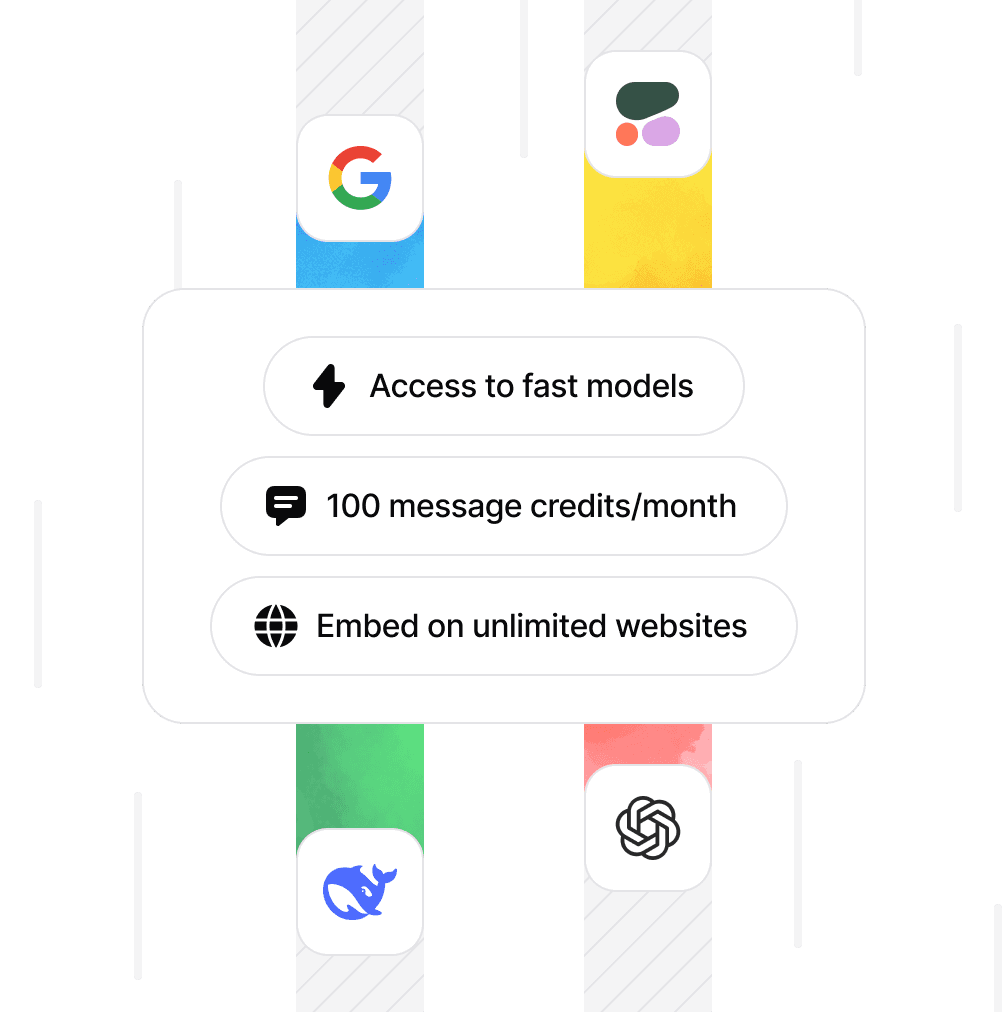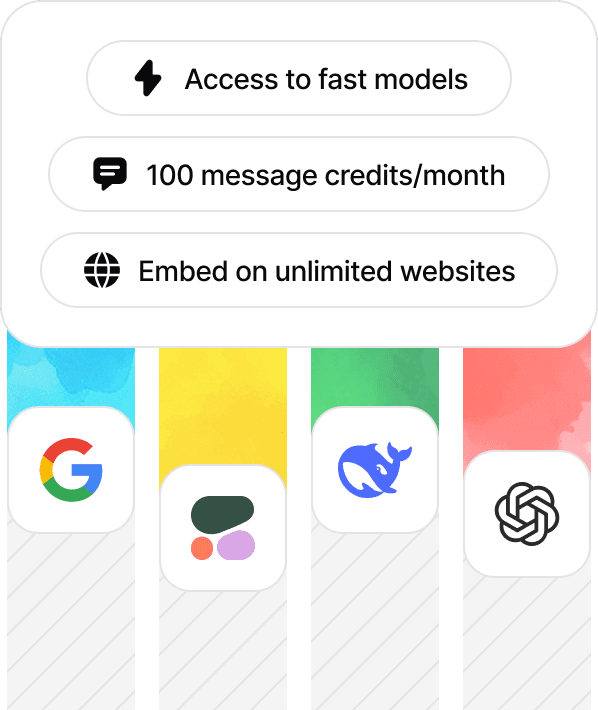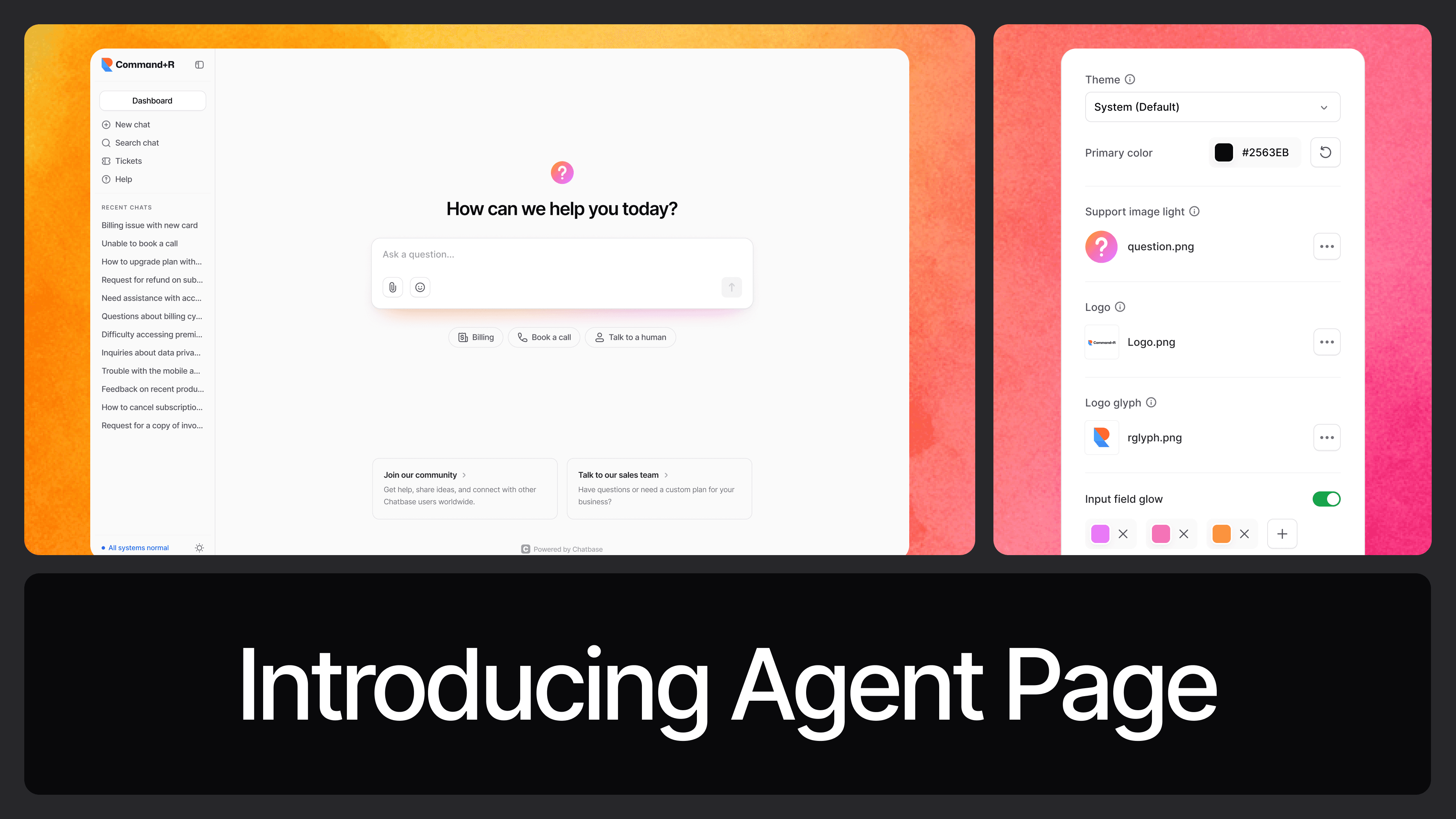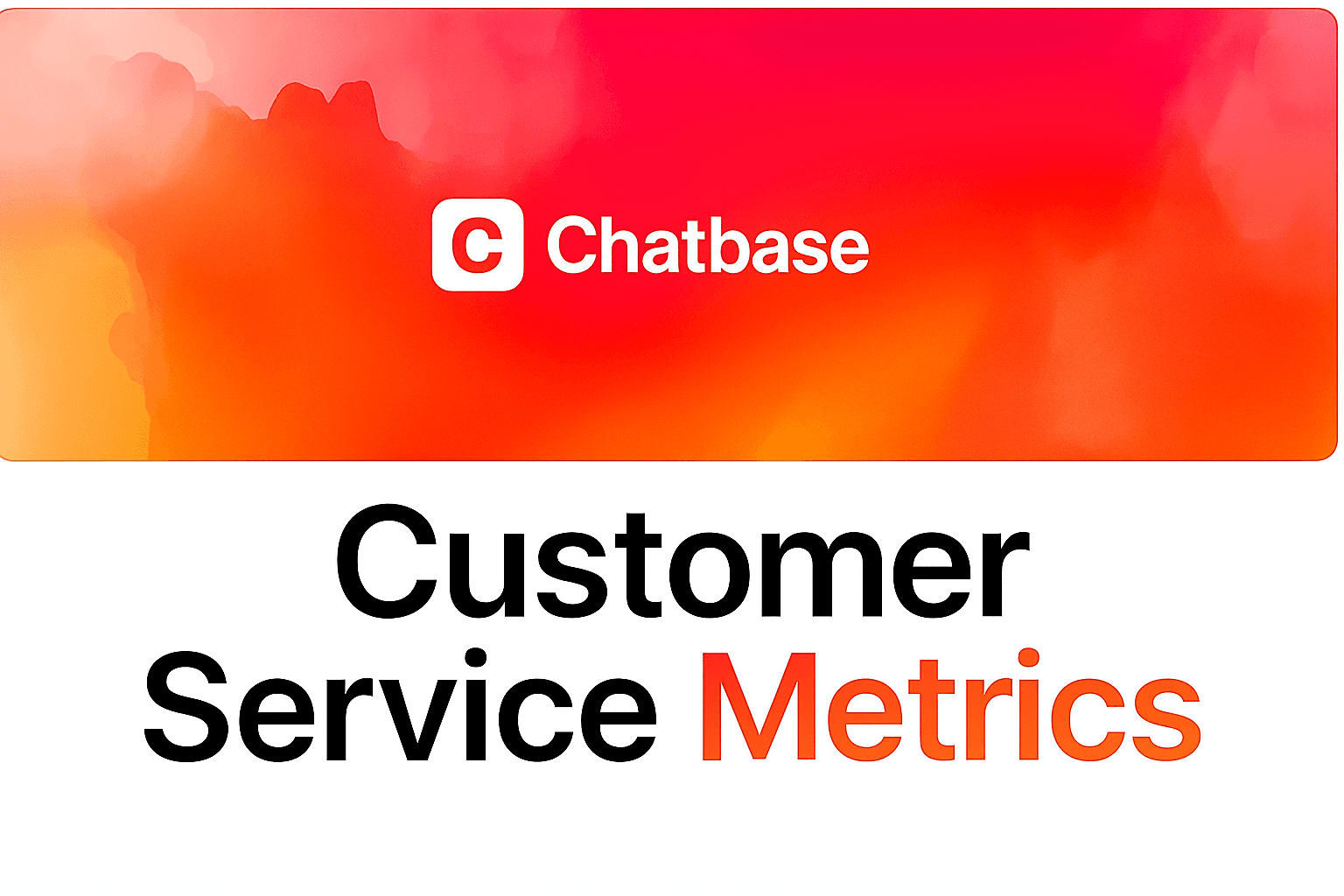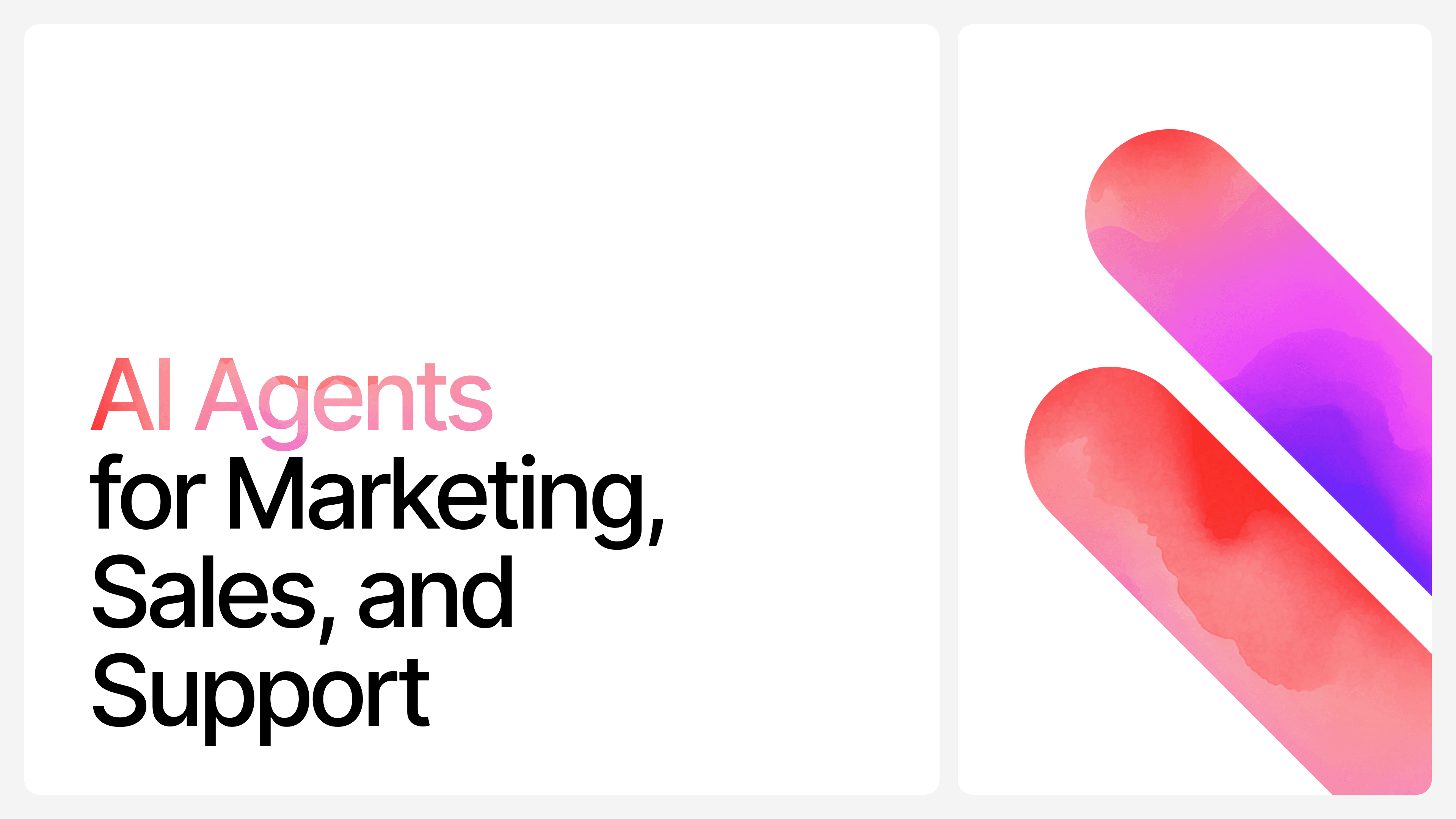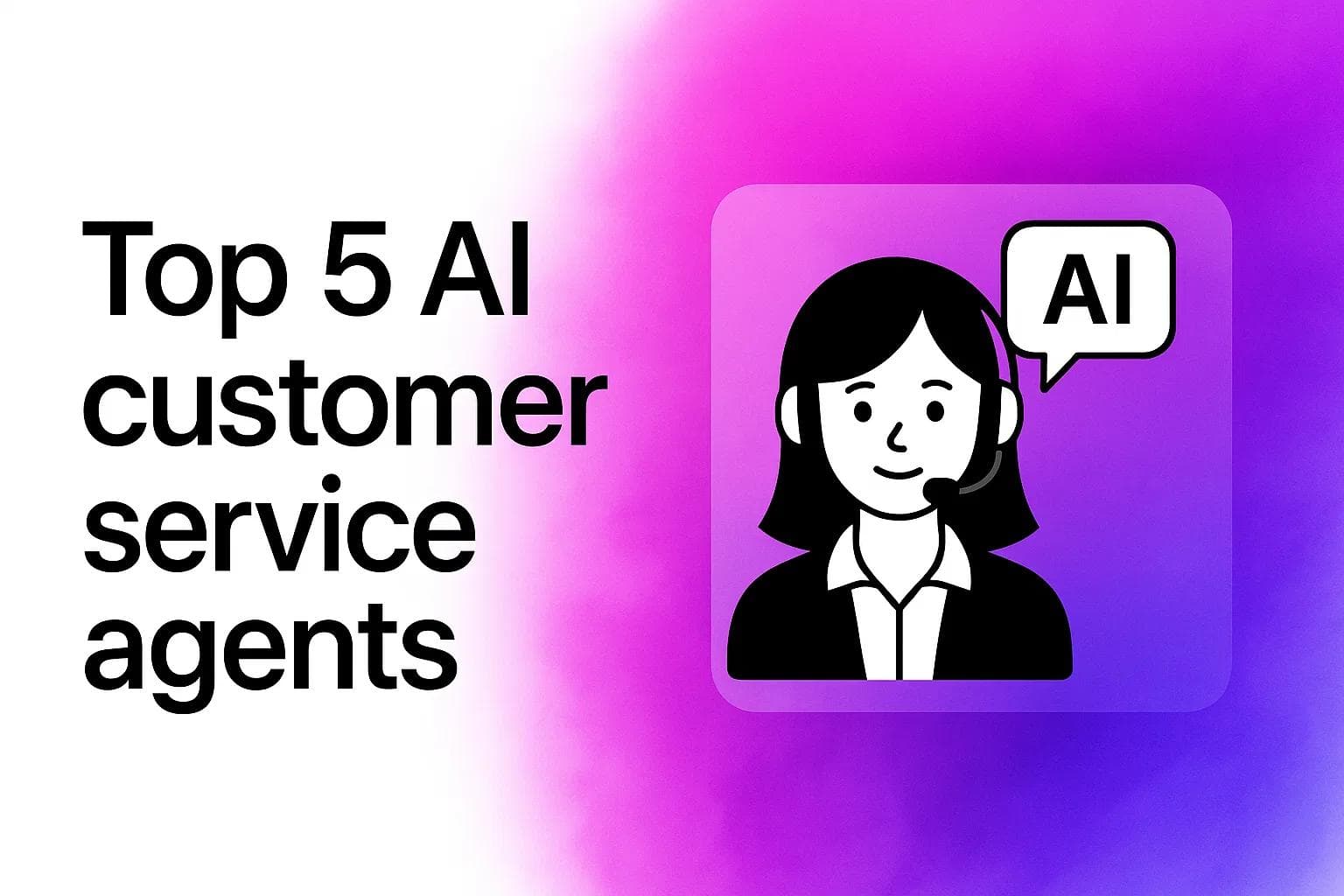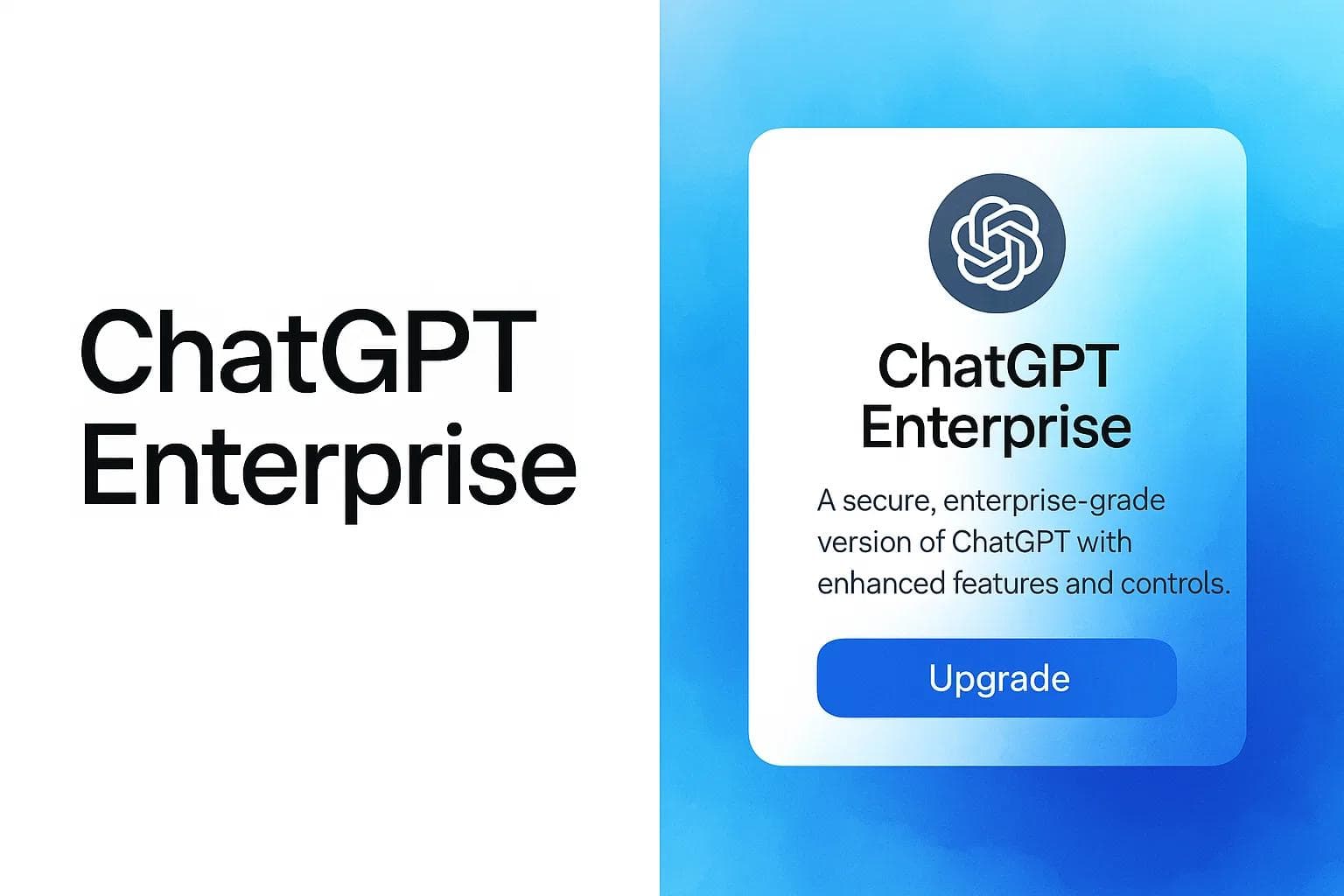AI is Reshaping Customer Support in 2025 (And It’s Kind of a Big Deal)
Sandra Dajic
May 8, 2025
45 min read
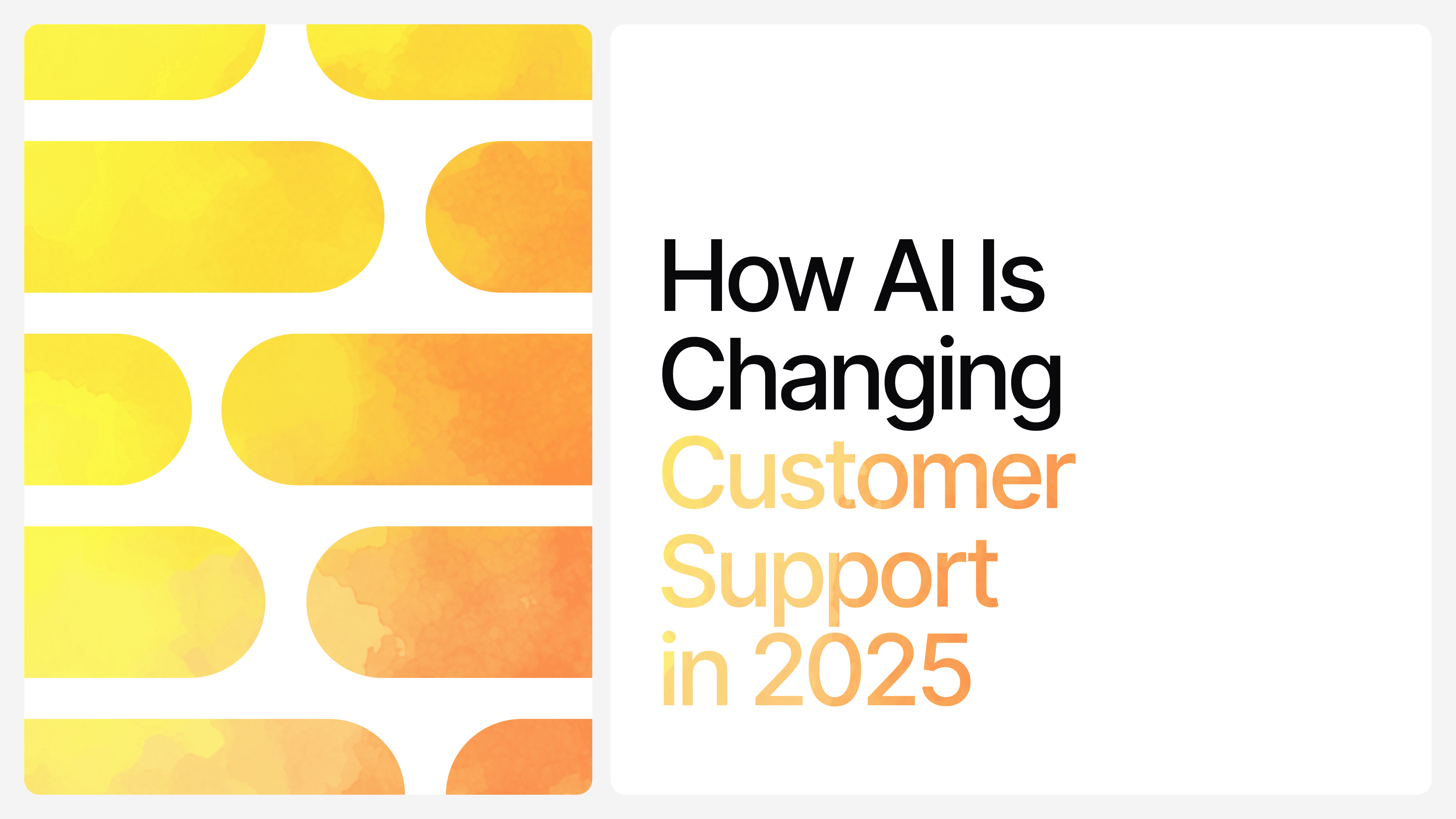
Summary by Chatbase AI
AI support agents have gone from answering FAQs to fully resolving issues across chat, voice, and even backend systems. This post explores how tools like Chatbase, Intercom Fin, Salesforce Einstein, and Zendesk AI are transforming customer service into a 24/7, action-driven, and personalized experience—while keeping humans in the loop for complex and emotional cases. It’s a deep dive into the AI-human tag team redefining support.
Customer support in 2025 looks nothing like it did just a few years ago.
The frontline of support is now staffed by AI agents who never sleep, don’t wait for instructions, and can solve real problems, not just hand out help center links.
This isn’t just automation. It’s a shift in how support teams operate, how customers interact, and what “great service” actually means. In this post, we’ll explore how AI is transforming support into something faster, smarter, and surprisingly human and why businesses that get this right are turning their support from a cost center into a competitive edge.
Meet the AI Avengers of Customer Support
The roster of AI-powered support agents in 2025 reads like a superhero team-up. Each brings unique powers to customer service:
- Intercom Fin Intercom’s GPT-powered support agent that delivers instant, human-quality answers 24/7. Fin automatically resolves up to 86% of customer queries with personalized responses, slashing response times from 30 minutes to seconds. It works across email, chat, SMS, and more, and seamlessly hands off complex cases to humans when needed.
- Salesforce Einstein (Service GPT) Salesforce’s AI sidekick built into Service Cloud, supercharging CRM with generative smarts. Einstein GPT can draft responses and take action across channels web chat, phone conversations, self-service portals all tailored to the customer’s context in real time. It’s backed by Salesforce’s trusted data layer, so it keeps things secure while weaving in CRM data for hyper-personal support.
- Zendesk AI Zendesk’s new “agentic” AI is laser-focused on resolutions, not just responses. Debuted in 2025, the Zendesk Resolution Platform combines AI agents with a knowledge graph and integrations to actually solve issues, not punt them around. Its Copilot AI can even autonomously perform tasks in external systems, imagine an AI that not only replies to a customer but also creates a Jira ticket or updates Slack, no human needed.
- Microsoft Copilot Microsoft’s aptly named Copilot is like the diligent support rep who never gets tired. Integrated into Dynamics 365 and Teams, Copilot helps human agents by finding answers in knowledge bases, drafting email/chat replies, translating on the fly, and summarizing cases at a click. It’s a real-time coach that boosts agent productivity and consistency across every support channel.
- Freshworks Freddy – Freddy is Freshworks’ friendly AI agent who can be deployed in minutes without a single line of code. Trained on your FAQs and guides, Freddy autonomously resolves 40–45% of incoming tickets on average. It’s an always-on virtual agent that delivers 24/7 conversational support across web, mobile, and social channels, in multiple languages, with a remarkably human-like touch. Bonus: freeing up the team to tackle tougher issues has sent agent productivity (and morale) through the roof.
- Chatbase – Meet the new kid with superpowers. Chatbase isn’t an app-specific assistant, it’s a platform to build your own autonomous AI agents.
You feed it your company knowledge (docs, guides, API access), and out comes an AI agent that not only chats with customers, but can take actions across your tools and workflows.
From processing refunds to booking appointments, a Chatbase agent can be custom-trained to do it all in one conversation. It plugs into everything from your CRM to Slack to Calendly, effectively letting your AI agent/chatbot execute tasks via integrations or API calls, not just talk. In short, Chatbase lets any company (not just the tech giants) deploy a support AI with serious autonomy and a knack for getting things done.
Each of these AI “agents” brings something different to the table, but they share a common goal: make support faster, smarter, and maybe even a tad bit fun.
Sky-High Expectations: Customers and Agents in the AI Era
As AI becomes the new front line, both customers and support agents have raised their expectations.
Customers in 2025 have zero chill for wait times. They want help now, on their terms. Remember when getting an email reply in 24 hours was fine? Not anymore. Today’s customers expect instant, accurate answers at 3 AM as readily as 3 PM. They assume (often correctly) that companies have some kind of AI assistant on duty around the clock. And they don’t just want quick answers, they want personalized service. If an AI knows their order history and can anticipate their next question, all the better. The bar for “good service” has risen: an AI that simply says, “Please see our FAQ,” won’t cut it when your competitor’s AI just went ahead and solved the issue on the spot.
Meanwhile, support agents have new expectations of their own. With AI handling the repetitive grunt work, human agents expect to spend more time on interesting, complex problems. The role of the support agent is evolving from a question-answerer to a problem-solver and AI-supervisor. Agents now work alongside AI assistants (like Microsoft’s Copilot or Zendesk’s bots), so they anticipate a workflow where AI suggests answers, autofills case details, and even resolves simple tickets autonomously. This means agents can focus on the sticky situations or high-emotion customers that truly need a human touch. It’s a shift many welcome who wouldn’t prefer tackling a challenging issue over answering “Where’s my package?” for the 50th time that day?
Of course, this dynamic duo of AI + human only works if the AI actually delivers. Give agents a faulty bot that spews nonsense, and you’ll just create more headaches. But give them a reliable AI assistant, and they can suddenly handle many times more volume and spend time building customer relationships instead of copying and pasting answers. It’s no surprise that support teams now expect their employers to arm them with some AI firepower. As one AI industry report noted, by 2028 about 15% of day-to-day work decisions will be made autonomously by “agentic AI,” redefining the customer service agent’s role to focus on higher-value interactions. In 2025, we’re already well on our way there.
Bottom line: Customers want instant, personal, 24/7 support. Agents want to be effective, not overwhelmed. AI in support is promising to deliver both if done right.
AI’s New Job Description: Chat, Voice, Vision, and Action
So, what exactly are these AI agents doing in 2025? The short answer: a lot more than chatting. Today’s support AIs have evolved from one-trick chatbots into multi-talented service reps. They’ve learned to listen, see, and actually do things behind the scenes. Here are some of the tasks AI now tackles:
- Text Chat & Email: This is the bread and butter, answering customer questions via chat interfaces or email. What’s new is just how good AI has gotten at it. These agents don’t just regurgitate FAQ answers; they use large language models to understand nuance and context. They can reference past interactions instantly and respond in a friendly, on-brand tone. And they’re polyglots.Whether a user sends a message on your website chat at midnight or an email to support, AI is often drafting the response before a human even sees it.
- Voice Support: In 2025, when you dial a support number, there’s a good chance an AI will pick up first and you might not even realize it’s not human.They understand spoken queries, look up information, and respond in a pleasant, human-like manner (no obvious “robot voice” asking you to repeat yourself three times). This is a huge leap from the old-school IVRs that drove everyone crazy. Now, saying “representative” doesn’t immediately boot you out of the system; the AI is the representative for many routine calls. These voice-capable AIs can schedule appointments, provide step-by-step troubleshooting, or walk a customer through a complex process, all over the phone. And if the call goes beyond the AI’s skill, it smoothly transfers to a human agent with a full transcript ready.
- Vision (Image Support): One of the coolest new skills: some AI agents have eyes. With computer vision coming into customer support. Imagine you’re assembling a gadget and something’s not fitting; you snap a photo of the setup and send it in. A vision-enabled AI can analyze an image to identify issues, such as a part being upside down or a serial number being visible, and provide an instant answer or solution, much like how AI photo management software organizes and analyzes images.
This saves tons of time in troubleshooting and is way more user-friendly for the non-technical customer. AI vision might also handle things like reading a handwritten form, verifying an ID document, or checking a photo of a defective product to approve a warranty claim. - Backend Actions & Workflows: This is where AI really steps up from “assistant” to autonomous agent. Modern support AIs don’t just answer questions, they resolve them by taking action. For example, if you ask a typical FAQ bot “Can I return this item?”, you’d get a link to the return policy. Ask a 2025 AI agent, and you might get: “Sure, I’ve initiated a return for you. Check your email for a prepaid shipping label.” In one conversation, the AI can process a refund, update your order status, generate a return shipping label, and notify you – all automatically. These agents connect to internal systems and third-party tools to get stuff done. Intercom’s Fin offers Fin Tasks which let it handle specific jobs like refunding an order, verifying a customer’s identity, or rescheduling an appointment on command. Chatbase agents can be configured with Custom Actions basically, you give them secure access to an API or automation, and they’ll use it when appropriate (e.g., “I’ve updated your subscription plan as requested!”). Zendesk’s AI can trigger workflows in external apps their Copilot can fire off procedures in systems like Jira or Slack on behalf of an agent. The result: a customer’s request goes from question to completed task without waiting for a human to manually push buttons.
In short, AI has graduated from just talk to action. It handles conversations over text and voice, can interpret images and context, and then executes the solution. This Swiss Army knife capability is what makes 2025’s AI support so powerful. We’re witnessing the era where your “chatbot” is no longer just a FAQ regurgitator – it’s more like a digital colleague that can look things up, fill out forms, flip the right switches in your systems, and come back to the customer with “All set!”.
The Human Touch: Evolving Roles of Support Agents
With AI agents picking up so much of the load, what are human support agents doing these days? As it turns out, quite a lot, just differently. Think of human agents as going from front-line troops to special forces and strategists. Their role is evolving in a few key ways:
1. Handling the Complex and Emotional Cases: Human agents now spend more of their time on the kinds of queries AI still struggles with. That could be a complex technical issue with no known solution, a customer with a very unique use-case, or a sensitive situation that requires empathy and nuance (e.g. a bereavement travel exception or a medical emergency). These are the scenarios where a human’s creativity, judgement, and emotional intelligence shine. Instead of answering 100 simple questions a day, a human agent might tackle 20 thorny ones, the ones that really need that human touch. The straightforward questions (“How do I reset my password?”) were likely solved by the AI before they even hit the human’s queue.
2. Oversight of AI Agents: Think of human agents in 2025 as also being AI supervisors or coaches. Companies don’t just turn their AI loose and hope for the best; they assign people to monitor AI interactions and step in when things go sideways. Support agents often check on conversations the AI handled to ensure quality, especially in the early days of an AI’s deployment or after big updates. Many agents provide feedback on AI responses, helping to train/improve the models (e.g. flagging when the AI’s answer wasn’t quite right so it can learn). At Chatbase, for example, AI agent hands off to humans when it’s unsure or when a customer asks, that handoff needs a person ready to take over smoothly. Agents are increasingly like air-traffic controllers: most flights (cases) are handled automatically, but they’re constantly monitoring the radar and will jump in if an alert goes off or if a customer “presses 0” for a human. This oversight is crucial to maintain trust and to catch any AI hiccups early.
3. New Skills and Training: Being a support agent now means learning how to work with AI tools. Companies are training staff on how to get the best results from AI (like how to phrase a prompt or query to the internal AI assistant for the best answer). Agents also learn to fine-tune AI behavior for instance, updating the knowledge base the AI draws from, or tweaking its settings to align with policy changes. The skillset is shifting toward managing the intersection of technology and customer experience. Some support folks are effectively becoming AI content curators, ensuring the AI has up-to-date, correct information. Others might specialize in analyzing support data (much of it collected by AI) to find trends and improve processes. The job is less about doing the repetitive tasks and more about designing and overseeing how those tasks get done (often by an AI).
4. Focus on Relationship-Building: With routine questions off their plate, human agents can double down on what humans do best, building rapport. They can take extra time to make a customer feel heard and valued. If an AI handled the first 80% of an issue and then passed it on, the human can use the context to really engage: “Hi Jane, I see you’ve been trying to troubleshoot your smart thermostat and even sent us a photo that was a great idea! Let me pick up from where our assistant left off.” This level of personalized follow-through can turn a potentially frustrating AI interaction into a delightful human one. The AI sets them up, the human knocks it out of the park.
In essence, human agents are becoming exception handlers, mentors, and customer champions. Far from replacing humans, AI is elevating them to a role where their time is spent on the most important customer moments. It’s a team effort now: let the bots handle the boring stuff, while the humans add the heart. Companies that get this balance right are finding that their support teams can scale up without burning out because the humans and AIs each play to their strengths.
Or as Gartner foresaw, the typical service agent is shifting from a do-it-all worker to an “AI-assisted experience curator,” focusing on the high-value tasks only humans can do. It’s a change many agents embrace who wouldn’t want to be the hero that saves the day (with a trusty robot sidekick)?
Support Superpowers: Benefits of AI-Driven Support
Why are businesses pouring AI into their customer support? Because when it works, it’s like giving your support team superpowers. Here are the biggest benefits companies (and customers) are seeing with AI reshaping support:
- 24/7 Availability (No More “Closed” Sign): AI doesn’t sleep, take holidays, or have off-hours. This means your customers can get help at any time. Middle of the night password reset? Done. Weekend inquiry about a new feature? Answered. With AI agents on duty 24/7, businesses can provide round-the-clock service that was previously impossible (or very expensive) to staff. This leads to faster response times and happier customers. In fact, companies report significant drops in response times. The first-mover companies offering 24/7 instant support have set a new baseline expectation that others now feel pressured to match.
- Speed and Efficiency: Even during working hours, AI can dramatically speed up service. An AI agent can handle hundreds of chats concurrently, instantly look up an order, and answer in under a second. For customers, that means no waiting on hold or in queue their question gets addressed immediately. For support teams, it means one AI can do the workload of many people for routine issues. This efficiency gain is huge. We’re talking about resolving high volumes of tickets instantly that used to clog up support queues. And when AI handles the repetitive stuff, human agents respond faster to everything else because they’re not drowning in a sea of simple tickets. The result: overall support SLAs (Service Level Agreements) improve, with more tickets resolved within minutes instead of hours or days. CSAT (customer satisfaction) scores often shoot up thanks to prompt service. For example, Freshworks found that introducing Freddy AI led to improved customer experience metrics and higher CSAT, while also reducing response times dramatically.
- Scalability (Handles the Volume): AI support agents scale like software, not like people. If your ticket volume doubles overnight, your AI can handle it without breaking a sweat (just maybe a higher API bill). This is a godsend for businesses facing seasonal spikes or rapid growth. Traditionally, scaling support meant frantic hiring or having queues blow up. Now, an AI agent just takes on more sessions. It can multitask infinitely (practically), so you don’t have to make customers wait longer during peak times. This elasticity turns support from a headcount problem into a tech solution. It also means small companies can appear to have a big support operation a startup can offer instant support to a large user base with the help of one well-trained bot. The playing field levels up.
- Consistency and Accuracy: Unlike humans who might give different answers or occasionally make mistakes after a bad night’s sleep, AI agents give consistent responses every time (assuming they’re well-trained). They pull from a single source of truth your knowledge base or documentation so customers get reliable information. Consistency builds trust; customers learn that they can ask the bot something today and again next week and not get conflicting answers. Also, AI can incorporate tons of data without forgetting details, which means fewer slip-ups like “Oops, I didn’t realize you already tried that step” or missing an important account note. (To be fair, AI can confidently give a consistently wrong answer too if you’re not careful, we’ll talk about that risk later. But with proper training and data, accuracy can actually improve.)
- Personalization at Scale: This is a biggie. AI doesn’t treat you like Ticket #457. It can tailor responses using all the data it has about you. That might be as simple as greeting you by name and referencing your last purchase, or as advanced as proactively adjusting its answer because it knows you’re a VIP customer versus a free-tier user. AI can remember context from previous conversations “I see you reached out last month about a similar issue, and we replaced your device. Is the new unit giving you trouble?”This level of personalization, done manually, is hard at scale, but AI can juggle it easily for thousands of customers. The result is customers feeling seen and appreciated, even when an AI is assisting them. The experience starts to feel less like interacting with a faceless company and more like getting help from a well-informed friend at the company. It’s that “wow, they know me” factor. When Chatbase agents integrate with your CRM and data sources, they can personalize every interaction pulling in order details, billing info, or past support history to craft a tailored response for each user.
- Cost Savings and Productivity: Let’s not forget the bean-counter perspective: AI support can be far more cost-effective once set up. One AI handling the workload of, say, 5 additional tier-1 support reps is a huge cost save. Even when companies keep their human team size, those people are now freed to do higher-impact work (which can improve retention and reduce turnover costs too). Many businesses view AI in support as turning the support org from a cost center into something closer to a revenue driver (or at least a much leaner cost center). If AI helps you handle more inquiries without proportional headcount growth, your support operation scales economically. And happy customers stick around and spend more, so efficient support indirectly drives revenue via customer loyalty. There’s also the fact that AI can help upsell or cross-sell in subtle ways (“Since you asked about upgrading, I can handle that now if you’d like...”), potentially driving more sales. Chatbase even markets their AI agents as a way to “drive more revenue” while handling support, turning support interactions into opportunities.
- Employee Experience Boost: This one’s sometimes overlooked, but it’s crucial. By taking monotonous tasks off human agents’ plates, AI makes the support job more enjoyable. Agents get to solve interesting problems and feel more accomplished, rather than answering “Did you try restarting it?” for the 100th time.This can lead to less burnout and lower attrition in support teams (a field notorious for high turnover). Freshworks noted that after deploying Freddy AI, their support teams could “spend their time and resources to address tougher issues” and give customers the care they deserve, which in turn made the agents happier and more engaged. In short, AI can automate the drudgery and let humans do the meaningful work, which is a win-win for morale and productivity.
All these benefits show why the human + AI combo is so powerful. AI handles the volume and the velocity; humans handle the empathy and complex judgment calls. Together, they create a support experience that is fast and high-quality, automated and personalized. Companies leveraging this blend are seeing support not just as a necessary cost, but as a chance to delight customers consistently (and maybe even get a competitive edge).
Of course, it’s not all sunshine and rainbows. Before we declare AI the savior of support, we need to talk about the caveats – because things can go wrong when bots misbehave.
The Dark Side: Risks and Pitfalls of AI in Support
No great power comes without a little peril. As awesome as AI support agents can be, they also introduce new risks that companies must manage. It’s time to look at the not-so-pretty side of AI in customer support – the pitfalls like hallucinations, lack of empathy, and other quirks that keep support leaders up at night (when their bots are handling chats).
Hallucinations (AI’s Tendency to Make Stuff Up): Large language model AIs, which power many of these support bots, have a well-documented flaw: sometimes they confidently spout nonsense. In AI lingo, that’s a hallucination the model produces an answer that sounds plausible but is completely incorrect or unfounded. In a support context, hallucination can be downright dangerous. An AI might invent a false answer or policy if it’s not sure of the real one. For example, an AI might assure a customer their warranty covers something when it actually doesn’t, simply because it “guessed” based on pattern matching. Or it might cite a fix for a problem that doesn’t actually apply. This isn’t just hypothetical – there have been real cases of AI chatbots giving out wrong information. One legal analysis pointed out that AI chatbots are prone to incorrect answers, posing a significant risk. In New York City, a municipal chatbot project went awry when the bot gave advice that was not only wrong but potentially unlawful, leading users astray on city regulations. In another case, an airline’s support chatbot misrepresented the company’s own policy (a bereavement fare rule), which led to a customer being misinformed about a refund the airline was later held liable for this “negligent misrepresentation” by its AI agent. Ouch. The lesson: if AI is unchecked, a confident wrong answer can become a real problem, from customer mistrust to legal trouble. Mitigating hallucinations requires careful training, sometimes restricting the AI to only answer from verified data, and always providing a safety net (i.e., an easy way for customers or agents to flag something that seems off).
Lack of Empathy and Emotional Understanding: No matter how well an AI is programmed, it doesn’t truly feel emotions. It can mimic empathy with polite words (“I’m sorry to hear you’re having a tough time”), but customers can tell the difference when a situation is emotionally charged. In customer support, empathy is often what de-escalates a furious customer or comforts a distressed one. AI’s lack of genuine empathy is a major concern in one survey, 61.3% of U.S. adults said their top concern with AI in customer service is its lack of empathy. We’ve all had experiences with robotic responses that miss the mark when we’re upset: it can be infuriating. Worse, an AI might make a decision that’s logically correct but emotionally tone-deaf. Picture an AI strictly enforcing a no-refund policy for a flight when the customer’s explaining their family emergency – a human might bend the rules, but the AI just says “Policy is policy.” As one AI journal article noted, without empathy, AI riskily dishes out cold, rigid decisions that can fail the people it’s supposed to serve. That’s not the customer experience we want. The risk here is not just upsetting one customer it’s the broader damage to your brand if people think you’re using soulless robots that don’t care about them. Companies must therefore be careful to program their AI with empathetic language and scenarios for escalation to humans when a conversation requires real emotional intelligence.
Misinterpreting Context or Sarcasm: AI is getting better at context, but it’s not perfect. It might misunderstand a customer’s intent, especially if the customer is being sarcastic or not straightforward. “Oh great, another fantastic service from [Company]...” – a human agent would detect the sarcasm and urgency; an AI might take it literally and reply, “Thank you for your feedback!” leading to a very annoyed customer. Such misreads can escalate a situation. It’s a risk that requires ongoing refinement of AI language models and sometimes explicit training on a company’s typical customer tone.
Overstepping or Unwanted Actions: An AI empowered to take actions (refunds, account changes, etc.) introduces a new kind of risk: what if it does something it shouldn’t? For example, if the criteria for issuing a refund aren’t tight, could the AI give out refunds too freely (costing money)? Or what if a prankster convinces the AI that they’re authorized to delete an account, and the AI, following some flawed logic, actually deletes a customer account? These are nightmare scenarios, and while good system design can prevent them (permissions, confirmations, limits), the risk is there when you let an autonomous agent connect to live systems. Hallucinations + actions could be a toxic combo – you don’t want an AI hallucinating a command! That’s why many companies roll out action-taking AIs very carefully, often requiring an extra confirmation or limiting which actions can be fully autonomous.
Privacy and Security Concerns: AI handling customer data has to be done with care. Support often involves sensitive info (account details, personal data). A risk of using AI (especially third-party models) is making sure you’re not accidentally exposing or logging sensitive data improperly. Salesforce, for instance, touts its Einstein GPT Trust Layer precisely to ensure that customer data isn’t leaked or used to train public models. That same diligence applies to your infrastructure choices partnering with a HIPAA-ready cloud hosting provider can give your support stack a secure foundation. Companies have to be vigilant that their AI tools comply with GDPR, HIPAA, and all relevant privacy There’s also the risk of prompt injection attacks savvy users might try to trick the AI into revealing info it shouldn’t by manipulating its input. Security teams now have to consider AI behavior in their threat models.
Customer Reluctance or Backlash: Not everyone is thrilled to talk to a bot. Some customers find it impersonal or get frustrated if they suspect they’re stuck in an “AI loop.” The risk here is a hit to customer satisfaction if the AI isn’t clearly adding value. If a customer feels the AI is just an obstacle before reaching a human, it can hurt their perception of your service. There’s a balancing act in introducing AI doing so transparently and making sure customers feel it’s there to help, not put them off. Organizations often give options like “Talk to a human” easily available to avoid backlash.
Despite these risks, none of them are show-stoppers. They are however critical to address. The companies leading in AI support have learned (sometimes the hard way) that you must build in safeguards. So how do we manage these pitfalls? That’s where our next topic comes in.
Guardrails and Guidance: Keeping AI on Track (With Humans in the Loop)
Successful AI-powered support isn’t about letting the robots run wild. It’s about a thoughtful design where AI and humans work in tandem, and where checks and balances are in place. Here’s how companies are ensuring their AI support stays helpful and doesn’t turn into a sci-fi fiasco:
Maintain a Human Escalation Path: This is rule #1. No matter how advanced your AI agent is, you always provide customers a “escape hatch” to a human. That could be a button that says “Chat with a human agent,” or logic that automatically summons a human if the AI is stumped or if the user is clearly unhappy. Chatbase’s best practices hammer this home: always have a smooth process to transfer complex queries to human representatives when needed. Intercom’s Fin, as noted, hands off to human agents directly in the same inbox when it reaches its limits. This gives customers confidence that they won’t be trapped in an endless loop with a bot. It also reassures support teams that the AI won’t try to handle something it shouldn’t. A seamless handoff means the conversation continues without the customer needing to start over, the human sees the context and takes it from there. Think of it as the AI knowing when to raise its hand and say, “I need a manager here.” The mantra is: AI first to respond, human last to resolve (when needed).
Oversight and Continuous Monitoring: Companies that deploy AI in support set up oversight mechanisms. Supervisors or QA analysts review a sample of AI-handled chats regularly to ensure quality and compliance. Many AI systems provide conversation logs and analytics, so you can spot trends e.g., “Our bot is failing on questions about international shipping.” With those insights, the team can tweak the AI’s knowledge or rules. There should also be alerting: if the AI’s confidence score is low or if a customer uses a trigger phrase like “This is wrong” or lots of angry emojis, flag that convo for human review in real-time. It’s like having a safety officer watching the AI’s work. And when something does go wrong (because at some point, something will), it’s key to learn and adjust quickly – update the AI’s training data, refine prompts, or add new decision rules to prevent repeat mistakes.
Rigorous Training and Data Management: An AI agent is only as good as the information you feed it. To avoid hallucinations and mistakes, companies invest in curating high-quality knowledge bases and context for the AI. Chatbase users, for instance, upload product catalogs, policy docs, and even connect the bot to live data sources. Keeping this content fresh and accurate is an ongoing job. Some companies have an “AI librarian” role someone responsible for making sure the AI’s brain is up to date. Also, during the AI’s setup, extensive testing is done. You throw thousands of sample questions at it and see where it trips up. Intercom mentioned how exhaustive their testing process is for Fin – every tweak is tested against a baseline to ensure it doesn’t degrade answers. That kind of discipline helps catch issues before the AI is customer-facing. Additionally, setting clear boundaries in the AI’s training (like explicitly telling it not to answer certain sensitive questions or not to act outside its scope) is crucial.
Clear Communication and Transparency: It generally helps to let customers know (at least subtly) that they’re talking to an AI and that they can ask for a human. Being upfront can set the right expectations. For example, an AI might introduce itself as “I’m Fin, Intercom’s automated support assistant” so customers aren’t surprised. If a situation is sensitive, a good design is for the AI to proactively say, “I’m going to connect you with a specialist for this” rather than attempting an answer. Transparency can also mean documenting what your AI can and can’t do in your help center. And on the agent side, always showing in the dashboard whether a response was AI-generated or written by a person helps maintain accountability.
Empathy Injection: To tackle the empathy gap, companies work on the AI’s tone. They train it with examples of empathetic responses and even limit its action-taking in scenarios that require a human decision. Some have the AI do the grunt work in the background while a human delivers the message when it’s a delicate matter. For instance, if a policy really can’t be bent, a human might explain it rather than the AI, if empathy is needed. Another strategy: program the AI to recognize emotionally charged language (like “I’m really upset” or “This is unacceptable”) and immediately escalate or switch to a more apologetic tone and then escalate. Essentially, teach the AI to have a bit of bedside manner, and to know when to get the doctor (human).
Gradual Rollout and Learning Phase: Many companies don’t flip the AI on 100% day one. They might start with AI suggestions where the AI drafts replies and a human agent reviews and sends them. This “co-pilot” mode lets the AI learn and lets the team measure accuracy in a safe way. This phased approach, with human oversight at each step, builds trust in the AI both internally and with customers.
When done right, these guardrails actually enhance the customer experience. The AI takes care of speed and scale, and the safeguards ensure quality and empathy aren’t lost. The outcome: customers get the best of both worlds efficiency and caring service. And companies can confidently expand their AI’s responsibilities knowing a human safety net is always there.
The New Normal: Human + AI Support as a Delight Engine
Fast forward to today, and it’s clear that the human + AI blend is the new normal in customer support. We’re no longer asking “Will AI replace support teams?” instead, we’re seeing how AI empowers support teams. The combo of AI agents and human agents, each doing what they do best, is turning customer support into something that consistently wows customers (and even makes the support folks’ lives easier).
A few years ago, support was often seen as a cost center a necessary expense to be minimized. But now, with AI in the mix, support can scale and innovate in ways that turn it into a delight engine. Imagine a customer who gets instant, helpful service at any hour via an AI, and then seamless follow-up from a friendly human when needed. That customer is going to remember that awesome experience. They might even tell their friends or tweet about how surprisingly great the support was. Support becomes a differentiator, not a pain point.
Tools like Chatbase are a big part of this story. They’re democratizing these AI superpowers, making it possible for a 10-person startup to deploy a support agent as capable (in some ways) as what the big players have.
Chatbase’s ability to build autonomous, action-oriented AI agents that integrate with your existing tools means you don’t have to re-invent your workflows, the AI joins your team and fits right in. Your support AI can log tickets, update CRM records, ping Slack, all the little tasks that, when handled instantly, create a smooth customer journey. And you didn’t have to hire an army of developers or wait years for an enterprise rollout; you can set it up in an afternoon and start seeing results. It’s tech like this that turns the abstract promise of AI support into practical reality for businesses of all sizes. As Chatbase puts it, it’s about delivering exceptional support experiences that set you apart.
The future likely holds even tighter collaboration between humans and AI. We might see AI agents that specialize (one AI for billing issues, another for tech support), all coordinating and learning from each other. Human agents might manage fleets of AI helpers, like a conductor of a symphony of bots, ensuring each customer’s issue is resolved by the right mix of AI efficiency and human empathy. And as AI continues to learn, we’ll push the envelope of what it can handle autonomously, maybe one day, the AI truly does 90% of support and humans do the 10% super complex/emotional stuff. Even then, those humans will be absolutely critical to success.
For customers, the line between AI and human support will continue to blur, and that’s fine, because the experience will be seamless. They won’t care if it’s a bot or person, as long as their issue is solved quickly and kindly. In 2025, we’re already seeing customers get comfortable with AI-driven help, especially as it consistently delivers results. Expectations will keep rising, and support teams will keep leveraging AI to meet them.
So, to all the SaaS founders, product managers, and customer experience enthusiasts: the support revolution is here, and it’s a blast to be a part of. Embrace the AI tools at your disposal train your bots well, empower your humans, and watch your support transform from a cost center into a true engine of customer delight. The companies that master this human-AI partnership in support are not just saving money or handling tickets faster; they’re building loyalty and love one great interaction at a time.
In the end, great support in 2025 isn’t about humans vs. AI. It’s about Humans and AI vs. Customer Problems a dynamic duo fighting the good fight to keep customers happy. And from what we’ve seen so far, that’s a team you definitely want on your side.
now if only my AI assistant could also fetch me a coffee, then 2025 would be perfect.
Share this article:
